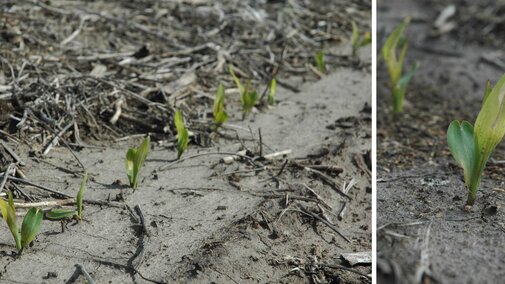Here’s a look at the when, how and what to look for.
Last week we saw soil temperatures plunge into the mid to low 40s, air temperatures fall into the 20s and 30s, and significant snowfall accumulation across parts of Nebraska. As a result, many of you may worry about the status of your early corn plantings (Figures 1-3) under such stressful conditions. It’s easy to jump to snap judgements about the fate of your crop, but it’s important to be patient and allow the crop to respond before evaluating your fields for potential replanting. Corn development during this cold snap ranged from recently planted up to the V2 stage. We will discuss the differences in impact for these development stages under cold temperatures and what to look for in the next few days.
Corn planted within 24 to 36 hours of cold soil temperatures can be prone to imbibitional chilling injury. At this point, seed are just beginning to take in water and expand. Cold temperatures can cause kernels to rupture during this process, leaving a swollen but non-functional seed. Once germinated, cold temperatures can damage the initial root system leading to stunting or death of the plant. In some cases, the mesocotyl can become deformed, resulting in the plant leafing out underground, corkscrewing, and possibly growing downward (Figures 4-6).
Robert Nielsen, corn agronomist at Purdue University, indicates that the temperature required for damage at this stage is not entirely clear; some sources indicate a threshold of 50°F, whereas, others indicate 41°F thresholds. With 4-inch soil temperatures in the mid 40s, it’s worth checking your fields. If you’re still planting corn in other fields, we would suggest that you continue planting for the next few days before scouting and making a decision on your earlier-planted fields. If your corn still hasn’t emerged, it’s probably best to dig up some plants and look for the signs of damage described above.
Corn plants that emerged prior to the cold snap may have a large amount of dead tissue above the soil surface, but there is a chance that these plants can recover. For more information on this see Risk of Freeze Damage in Early Planted Corn (CropWatch). The growing point of V2 stage corn is still well below the soil surface and will remain there until about the V6 stage. These plants are not entirely immune to cold temperatures — a hard frost can penetrate the ground and kill them.
Market Journal author Justin McMechan discusses potential issues with corn given recent cold temperatures and snow in much of the state.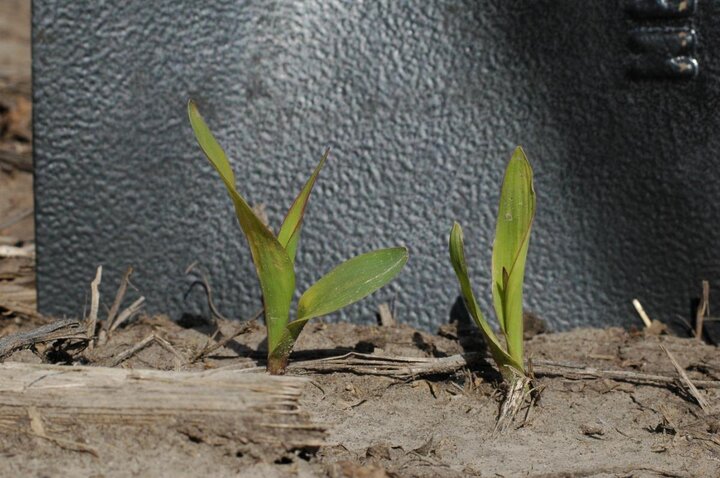
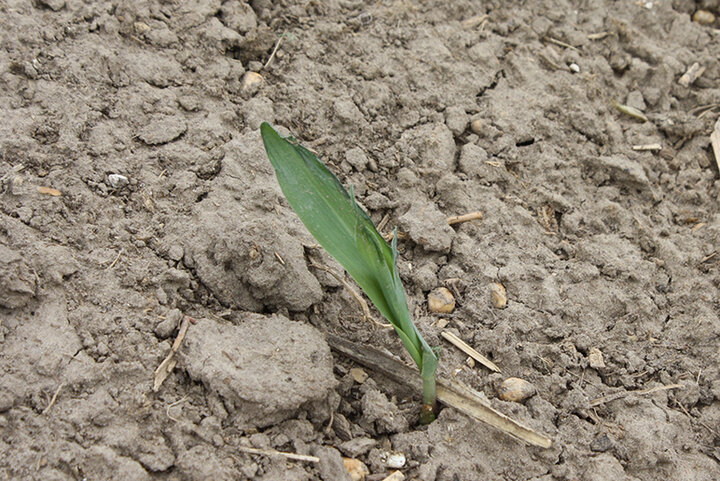
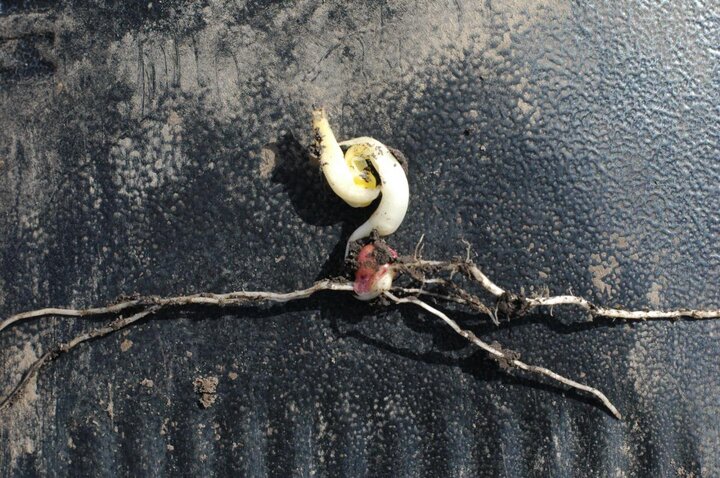
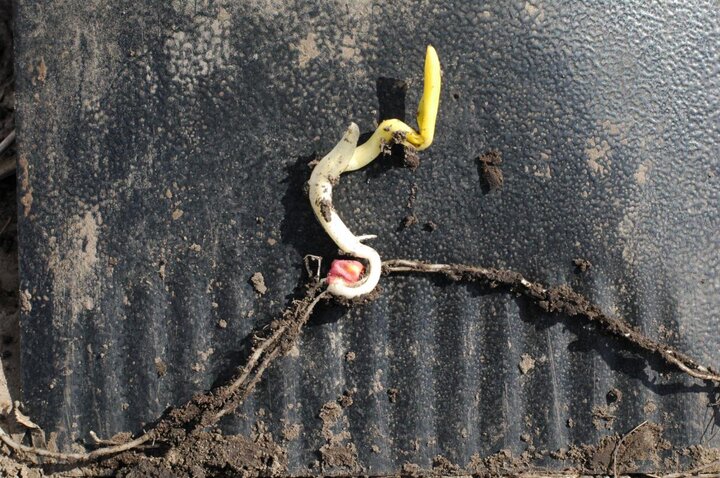
If your corn was emerged, but now isn’t growing vigorously, it’s important to dig up several plants and cut them lengthwise to evaluate the health of the plant. Cross sections of healthy plant stems should appear mostly white (Figure 7), whereas damaged or dying plants will usually have a brownish tinge. In some cases, newly emerging corn leaves on recovering plants may become trapped in the dead leaf tissue, a condition known as “buggy whipping.” It may be tempting to shred these plants, but research conducted by UNL Extension Crop Specialists Roger Elmore and Ben Doupnik in 1995 showed that clipping V3-V4 frost-damaged corn did not increase yields and reduced plants stands.
Evaluating Replant Options
To evaluate corn for replanting it’s important to take stand counts from at least three random and representative locations within the field. Evaluations for plant stands are typically made on 1/1000th of an acre. In 30-inch rows evaluations would be made on 17.4 feet of row at each location; 20-inch rows would require 23.8 feet of row per site. Evaluate each of the plants within this row and determine remaining number of live plants. It’s important to take note of any large gaps between live plants within the row as these can lead to additional losses. Five- to six-foot gaps can lead to an additional 5% yield loss.
To determine yield impacts, see Table 4 (page 7) in the Nebraska Extension resource, Evaluating Hail Damage to Corn. Stand losses are based on 1/100th of an acre so be sure to adjust your counts to match the table. Before you replant, you’ll want to take into consideration the existing yield potential based on the remaining plant stand, calendar date, cost of seed, additional pesticides or tillage, fuel, etc.
Impact of Snow
Snow accumulation on emerged corn is not a situation with which we have much experience. It’s possible that large snowfall accumulations may have buffered corn plants against colder atmospheric temperatures, but it’s also possible that the snow may have caused some damage. If you had significant snowfall accumulations on emerged corn, we’d like to hear from you so we can learn more about its potential impact.

Resources
- Evaluating Hail Damage to Corn, Nebraska Extension EC 126.
- Early-planted corn and cold weather. Corny News Network, Nielson, R. L. 2012. Purdue University. Department of Agronomy.
- Corn Recovery from Early-Season Frost. Roger W. Elmore and Ben Doupnik. Journal of Production Agriculture 8, no. 2 (1995): 199–202. doi:10.2134/jpa1995.0199.
- Corn Field Guide, 2nd edition, 2013. Iowa State University Extension.
Example Assessment
If you planted 35,000 seeds per acre on April 25 and 25,000 plants per acre remained and you cannot replant until May 20, it would be better to leave your present stand, which has 95% yield potential, than to replant on May 20 when the yield potential for a stand of 30,000 would be 86%, based Table 1. Make sure you consider replant costs in your decision. Note: Values used in Table 1 are based on preliminary Iowa research and modeling, detailed in the Iowa State University Extension Corn Field Guide, 2nd edition, published in 2013. The 100% yield potential is estimated to occur with a 35,000 plant population and early planting.
| Table 1. Relative yield potential of corn by planting date and population | |||||
|---|---|---|---|---|---|
| Planting Date | |||||
| Population | April 20–May 5 | May 5–15 | May 15–25 | May 25-June 5 | June 5–15 |
| (Plants/Acre) | Percent Maximum Yield | ||||
| 45,000 | 97% | 93% | 85% | 68% | 52% |
| 40,000 | 99% | 95% | 86% | 69% | 53% |
| 35,000 | 100% | 96% | 87% | 70% | 54% |
| 30,000 | 99% | 95% | 86% | 69% | 53% |
| 25,000 | 95% | 91% | 83% | 67% | 51% |
| 20,000 | 89% | 85% | 77% | 63% | 48% |
| 15,000 | 81% | 78% | 71% | 57% | 44% |
| 10,000 | 71% | 68% | 62% | 50% | 38% |
